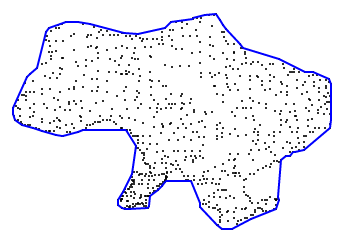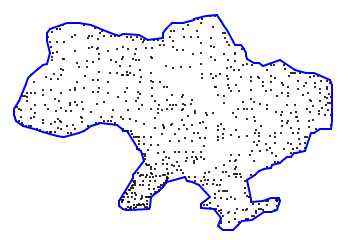Hull.js is a JavaScript library that builds concave hull by the set of points.
This library was born in free independent Ukraine. Today not only Ukraine, but the entire international rule-based order is under attack, and you can help to defend it by supporting the Armed Forces of Ukraine via well trusted https://savelife.in.ua/en/ foundation. For other options to help, explore https://ukraine.ua/.
See live examples here.
var points = [ [236, 126], [234, 115], [238, 109], [247, 102], ... ];
hull(points, 50); // returns points of the hull (in clockwise order)
- 1st param - array of coordinates in format:
[[x1, y1], [x2, y2], ..., [xn, yn]]; - 2nd param - concavity.
1- thin shape.Infinity- convex hull. By default20; - 3rd param - points format. For example:
['.lng', '.lat']if you have{lng: x, lat: y}points. By default you can use[x, y]points.
Let's see step by step what happens when you call hull() function:
-
Hull.js takes your source points of the shape:
-
Builds convex hull:
-
After that, the edges flex inward (according to the `concavity` param). For example:
This library relies on ES6. The ES6 features used are:
new Set(null),Set#add,Set#haslet,constMath.trunc(if available)
You may use polyfills for Set and compile with babel to continue to support old browsers.
npm install # install dependencies
npm test # build dist file and run tests
npm run watch # watch ./src dir and rebuild dist file
If you want to get involved with Hull.js development, just use github flow and feel free to contribute!
- think about holes;
- think about automatic
concavityadjustment based on density.
- Implementation of a fast and efficient concave hull algorithm;
- Computational Geometry: Convex Hulls;
- Andrew's monotone chain convex hull algorithm;
- Line Segment Intersection Algorithm;
- Game Math: "Cross Product" of 2D Vectors;
- Угол между двумя векторами;
- Когда не нужна тригонометрия.
- Fix issue with formatting when users pass less than 4 points as an input.
- Remove bower.json, as Bower itself is deprecated.
- Clean up .gitignore.
- Add "debug" folder to .npmignore to reduce tarball size.
Introduce fix that avoids hitting stack size limit on large arrays.
- Change language level to ES6.
- Performance improvements.
Return the first point as the last point when fewer than 4 unique points are provided.
Fix missing "var" declaration.
- Fix modification of the initial array.
- Add filtration of the duplicates.
Add edgeSkipList to increase performance of the highly accurate shapes (with the small concavity number) + refactoring.
Fix bower.json.
Fix bower.json.
Bower support.
Minor fixes (copyrights).
Minor fixes (readme, package.json).
Configurable point formats, now you can use points like {x: 10, y: 10} and {lat: 52, lng: 82}.
Some minor updates (doc, package.json, etc.).
Second version with better performance inspired by this article.
First version based on Delaunay triangulation.




